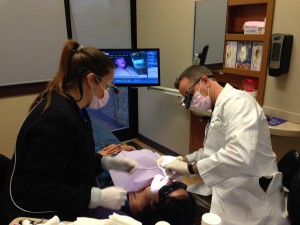THE BACTERIA IN OUR BODIES vastly outnumber our human cells! And no matter how much we brush, floss, or rinse, our mouths will always be home to billions of microbes. However, that’s not necessarily a bad thing!
Different types of bacteria keep others in check, and most aren’t anything to worry about. But maintaining this balance requires some effort on your part—to support the good bacteria and limit the growth of the bad.
Our Oral Ecosystems
Recent studies estimate that there are about 1000 species of oral bacteria, with 100 to 200 in any given individual. Microbes live off nutrients found in saliva, and on our gums, teeth and tongues. In a healthy mouth, beneficial bacteria fight disease-causing germs and fungi. They’re actually our immune system’s first responders! The constant flow of saliva also helps keep acid-producing bacteria from getting established. But even with all these defenses, harmful microbes can still upset the balance.
Bad Bacteria Causes Bad Breath
Poor oral hygiene and other conditions like dry mouth create an environment in which harmful bacteria thrive. An excess of sugar residue from candy, soda and other foods speeds up the already explosive microbe growth. The bacterial imbalance can result in chronic bad breath, canker sores, higher risk of illness, tooth decay and other problems.
5 Steps For A Healthy Oral Environment
By following a good oral care routine, you can make sure the scale is always tipped in favor of the good bacteria! Create an oral environment that promotes beneficial microbes with these five steps:
- Brush your teeth twice a day
- Floss daily, and scrape your tongue daily
- Limit consumption of foods high in sugars, and rinse with water after eating
- Avoid dry mouth by chewing sugar-free gum
- Don’t share toothbrushes or other items that touch the mouth
Since every oral environment is different, there may be other factors that are influencing your personal flora and fauna. As you come in for regular dental checkups, we can keep tabs on your unique oral profile. Together, we’ll determine a personalized plan if anything needs to be changed to keep your mouth at its healthiest.
We’re honored to be your partner in the pursuit of a healthy lifestyle. Thank you for being our valued patient!
 Lake Oconee Dentistry will host a free day of dental care, in association with Dentistry from the Heart, on Friday, September 30th at its office located at 1011 Parkside Main, between the Publix parking lot and the movie theater in Greensboro.
Lake Oconee Dentistry will host a free day of dental care, in association with Dentistry from the Heart, on Friday, September 30th at its office located at 1011 Parkside Main, between the Publix parking lot and the movie theater in Greensboro.
 This year marks the 18th anniversary of Lake Oconee Dentistry. Owned and operated by Drs. David and Patti Bradley, the practice provides standard preventive maintenance exams and cleanings, as well as a variety of cosmetic and restorative dental enhancements.
This year marks the 18th anniversary of Lake Oconee Dentistry. Owned and operated by Drs. David and Patti Bradley, the practice provides standard preventive maintenance exams and cleanings, as well as a variety of cosmetic and restorative dental enhancements.

 Lake Oconee Dentistry will host a free day of dental care in association with Dentistry from the Heart on
Lake Oconee Dentistry will host a free day of dental care in association with Dentistry from the Heart on 